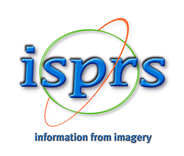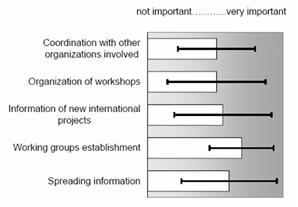|
Bringing together the multidisciplinary scientific community addressing desertification issues: The European DesertNet Initiative (EDN). Prof. Dr. Carlos San Juan Mesonada (Department of Economics, University Carlos III of Madrid, Spain); Dr. Mariam Akhtar-Schuster (University of Hamburg, Germany); Dr. Begni, G. (Cnes). DESERTIFICATION, A SERIOUS WORDWIDE CONCERN Desertification is a severe degradation of land induced by complex coupling between economic agents activity and natural factors in arid, semi-arid and sub-humid regions. Presently, 39,2 % (about 5.2 billion hectares) of the world are under threat, which bring vulnerable local people to extreme poverty situations. It may lead to massive human displacement which can not only generate economic problems to other regions but also frequently generate national and international tensions. Some 900 million people are estimated to be under threat - a figure that could rise to over 2 billion people by around 2050. This unacceptable situation has brought a wide international solidarity move. The most visible event is the UNCCD declaration (United Nations Convention to Combat Desertification), which was adopted in Paris on June 17, 1994 and entered into force on December 26, 1996. . European DesertNet (EDN) can be seen as a 'bottom-up' concerted contribution of European scientists to a wide international effort. Due to immense worldwide interest of the scientific community, European DesertNet since December 2006 allows membership of non-European scientists, specifically inviting scientists from affected countries to join it - which makes it of specific interest for ISPRS. The EDN aims at identifying cutting-edge science and transferring scientific knowledge generated in the research projects of the EDN members to end user organizations as well as providing mechanisms to evaluate the on going policies to combat desertification from the economic and scientific point of view. Underlying strategies include such various and interacting themes as water efficient management, introduction of species resistant to dryness conditions, better management of land productivity, stopping irrigated lands losses, demography, local micro-economic measures. They imply both a long-term situation global monitoring and a specific focus on endangered areas or zones under mitigation and remediation measures. Taking a joint advantage of remote sensing multi-scale time series of remotely sensed products with in situ various data collected according to strict protocols is expected to bring a unique tool to answer this dramatic challenge. INTERNATIONAL ORGANIZATIONS AND CIVIL SOCIETY International organizations have been politically endorsed worldwide. Their deep willingness and commitment to lead their mission to the benefit of the most vulnerable populations is by no ways questionable, but efficiently harmonizing this 'top-down' approach with an actual participation of the civil society such as local population, local managers, NGO's, scientists, servicing structures, private sector, etc, remains challenging. Nevertheless, joining the 'bottom' and the 'top' is mandatory to get efficient and sustainable achievements. Actually, many 'bottom-up' initiatives are flourishing and are needed to build success stories. Most often, they tend to build up dedicated intermediate structures that can efficiently build up a common language for a better interaction between the 'bottom' and the 'top'. EDN can be perceived as one of them. Desertification is not just a theoretical scientific approach but also an applied know-how to design policies. Most scientists involved in desertification research are in close contact with interactions between hard environmental conditions and people who are fighting to survive. The human sense of solidarity and the scientific understanding of the needs of multidisciplinary research at an ambitious level can explain why scientists decided to join their efforts through the EDN structure and its associated worldwide network. They want to work hands in hands with 'sister associations' such as ISPRS. EDN is also willing to contact economic agents that work in mitigation and remediation projects or are affected by desertification consequences of the desertification process like insurance companies, infrastructure operators, farmer organizations, companies producing mitigations devices, and public administration at local and regional level in the affected areas. EDN: A SHORT STORY The beginning of the story is a German initiative, when national researchers about desertification issues decided to join their efforts through a dedicated scientific network - 'Desert*Net Germany' .
For this purpose, EDN - basically a European initiative - is open to all scientists within and outside Europe wanting to join it and collaborate with it. EDN supports the UN environmental conventions, in particular the UNCCD. It intends to strengthen the cooperation with its scientific body, the Committee on Science and Technology (CST) and is open to collaborate with all other UNCCD panels or groups, in need of scientific input. EDN is also looking forward to collaboration with international organisations, programmes and agencies in need of scientific information or advice. EDN is firmly based on the idea of creating a global network of scientists who are interested in the topic and who share the vision and the objectives delineated in the Declaration of the European DesertNet. So, it is open to all scientists in the world. EDN is prepared to put its knowledge its understanding to the service of combating desertification and creating sustainable livelihoods in drylands through sound scientific work.
EDN is led and coordinated by a Chair: Prof. Dr. Carlos San Juan Mesonada, University Carlos III of Madrid, Spain) and a Co-Chair & Secretary (office leader): Dr. Mariam Akhtar-Schuster (University of Hamburg, Germany).
A SHORT INSIGHT ON PRESENT ACTIVITIES AND PROJECTS The EDN started working as soon as its objectives and structures were endorsed and consolidated. Fig. 1 - Results of the EDN immediate expectations questionnaire.
CONCLUSION: EDN and ISPRS ISPRS is a 'non-governmental international organization, devoted to the development of international cooperation for the advancement of knowledge, research, development, education and training in the photogrammetry, remote sensing and spatial information sciences, their integration and applications, to contribute to the well-being of humanity and the sustainability of the environment' (Statute I.) It can be considered as a 'vertical' structure It brings together among others scientists, service providers, industry in the related fields. It includes eight Technical Commissions. Among others, Commission IV is about 'Geodatabases and digital mapping', Commission VI is about 'Education and Outreach', Commission VII is about 'Thematic processing, modelling and analysis of remotely Sensed data', Commission VIII (newly created in the period 2000-2004) is about 'Remote Sensing applications and policies'. |
|
|

